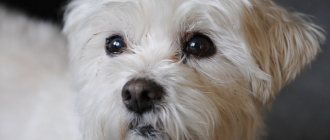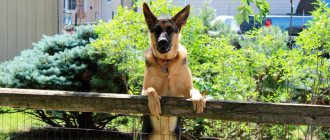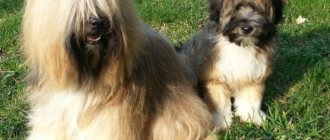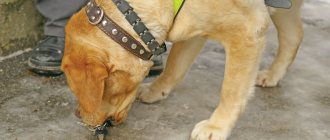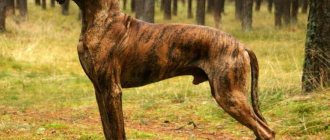Main characteristics
| Breed parameters | |
| Country of origin: | Tibet |
| Weight of the breed: | males: 6-8 kg, females: 5-7 kg |
| Height at withers: | males: 25-28 cm, females: 25-28 cm |
| Temperament: | moderate |
| Wool: | long |
| Role in human life: | companion, watchdog |
The Lhasa Apso is an amazing dog that makes you fall in love at first sight. These animals are truly luxurious and endowed with an aristocratic appearance. They are playful, excellent as a companion, and, if necessary, are ready to show character and defend their owner.
Appearance of Lhasa Apso - detailed description
The pet's appearance is well balanced. The dog has strong bones, a long coat and an abundance of colors. The average height at the withers is about 23 cm. The weight of an adult varies from 3 to 8 kg. The average life expectancy is 14 years.
International standard:
- head – moderately narrow skull, which visually tapers towards the back of the head. The muzzle is slightly convex, however, not bullseye shaped. Soft transition from forehead to nose. The nose is slightly flattened, usually painted in dark palettes;
- eyes – round shape, medium size, dark color, set straight;
- ears are hanging form, covered with a thick layer of hair, which hangs down and visually lengthens them;
- jaws – reverse scissors bite (upper incisors closely touch the outer side of the lower ones), wide arrangement of incisors;
- neck – rather curved, short, muscular;
- body – compact rectangular shape, straight back, convex ribs, strong loin, rounded croup. The length of the body is greater than its height;
- limbs - the shape of a cat's paws, with pronounced pads. Paws are straight and strong. The muscles are well developed, the angles are correctly set. The hock joint has a parallel structure;
- dynamics – fast and free steps;
- tail – set high, thrown over the back when moving, a slight bend is observed at the end of the tail, covered with a thick layer of hair;
- wool - luxurious hair covering the entire body, the hair is quite hard and straight, without curls. The texture of the coat is not silky. There is an undercoat of medium density. The hair forms a visual whisker and falls over the dog's eyes;
- color - there are a variety of palettes, but the most traditional colors are considered to be the following: beige, honey, gold, gray, sable, black, tortoiseshell.
Photo: Lhasa Apso
Tibetan temperament
The breed is an excellent companion and vigilant watchdog. In general, the pet’s character can be called independent and freedom-loving. It is recommended to teach puppies discipline from childhood so that they obediently accept commands and feel free in society.
The Lhasa Apso has remarkable intelligence, thanks to which it easily remembers commands and is quickly trainable. It is recommended to use a playful form and a creative approach in education. Dogs get along well with children and enjoy frolicking with other animals.
The breed has well-developed hearing and sense of smell, making the animals impeccable watchdogs. Pets are wary of strangers. But as soon as the owner shows hospitality, the dog’s unfriendly attitude is replaced by a warm welcome.
Lhasa Apsos respect every member of the family, but they see only one person as their owner. They obey his orders and commands unquestioningly. Pets do not like physical activity too much; they do not require long walks. The breed is great for older adults and families who lead a moderate or inactive lifestyle. Dogs can go without walking for weeks, provided they have plenty of leisure time in the house.
Dogs are distinguished by their strong psyche and resistance to stress. Therefore, they easily endure travel and transportation. Representatives of the breed also take it easy to change their place of residence. The main thing is that the owner remains nearby; changing the “scenery” does not matter much.
Lhasa Apsos are overly attached to people and it is not recommended to leave them alone. Sometimes pets tend to succumb to bouts of laziness. They can lie on the sofa for long hours and will not budge unless they are encouraged.
The pet loves to be the center of attention. The breed can safely be called “the life of the party.” The Lhasa Apso retains his childishness even into adulthood, so his “arsenal” should have an impressive number of toys. Pets do not need a separate place in the house. They love to sleep next to people, perhaps even in the same bed. They are distinguished by cleanliness.
Photo: Lhasa Apso
Possible health problems:
- kidney diseases;
- heart failure;
- allergic reactions;
- increased lacrimation and cataracts.
Vigilance of the owners and regular examinations by the veterinarian will help maintain the health of the pet properly. With proper care, a pet can live more than 20 years. The record holder in this area is the dog Tim, who lived for 29 years.
Caring for a Miniature Tibetan
The main advantage of the breed is its amazingly beautiful coat, which requires proper care. The dog needs to be brushed after every walk. Since animals love to frolic, wade deep into the thickets, and explore various objects. To care for your Lhasa Apso you will need a special brush and comb. It is necessary to devote at least half an hour to combing; the fur coat should be combed along the line of hair growth from the roots. After each walk, you should wash your pet’s paws and belly, so the puppy must be accustomed to water procedures from the first days of its appearance. A pleasant aspect of keeping this breed is that it does not shed, so owning such a dog is not contraindicated even for people with allergic reactions.
To maintain the good condition of your pet's coat, it is necessary to cut it every season. You should brush your dog's teeth weekly with a toothbrush and pet toothpaste. At the same frequency, it is necessary to clean your pet’s ears with a cotton swab. It is recommended to wipe your eyes daily.
It is recommended to trim the animal's claws, since an inactive lifestyle does not allow them to be worn down naturally. After each meal, you should wash your pet and clean its “whiskers”. It is also recommended to trim the fur on the paw pads as needed.
Pets should be bathed frequently – once every 2-3 weeks at least. For this purpose, professional cosmetics for animals are used, since representatives of the breed are prone to allergic reactions and dermatitis. In rainy weather, it is not recommended to walk the Lhasa Apso, since frequent bathing will also not benefit the animal, and you cannot leave the fur dirty (tangles and tangled curls cannot be untangled, all that remains is to cut the animal shorter).
Dogs can tolerate temperature changes and cold conditions well, but this should not be abused. It is recommended to keep your pet indoors during the winter. In the summer, the best option would be to “dwell” the dog in the courtyard of the house with a personal booth. The Lhasa Apso is able to get along in almost any conditions and accepts living conditions in a private house and a city apartment equally well.
Making a smart diet
Lhasa Apsos are very demanding when it comes to nutrition; their body needs a balanced diet. It is quite difficult to create the correct daily menu for your pet. Therefore, experienced breeders recommend using premium dry food.
The pet should always have clean drinking water at its disposal, which must be changed several times a day. If the dog does not drink enough water, kidney stones can be deposited in the dog, which will lead to the development of a number of diseases or even the death of the pet.
If you choose “home cooking,” you should give preference to lean meats. They should only be prepared by boiling or stewing. It is recommended to give your pets fillet. From fermented milk products, Tibetans should be fed medium-fat cottage cheese and milk.
Eggs are allowed to be given no more than 2 times a week. The use of fish should be avoided. Recommended cereals are pearl barley and rice. Vegetables are needed to keep your pet healthy. Lhasa Apsos love potatoes, corn, boiled carrots, cucumbers and greens.
Fruit is allowed on the dog's menu; the only taboo is citrus fruits. Experts recommend the use of vitamin supplements, which will have a beneficial effect on the coat and overall health of the Lhasa Apso.
Features of education:
- training in the form of a game, you cannot frighten the puppy, grab him, or raise your voice;
- physical force cannot be used as punishment; it will be enough to shout at the pet, which is extremely susceptible to the owner’s mood;
- early accustoming to being held; at first, treats can be used as reward;
- training to use a leash and collar as an integral part of a walk;
- accustoming the puppy to the toilet, which should be similar to the breeder’s toilet (fabric rag, oilcloth). This breed does not require daily walks, so it is necessary to accustom your pet to the rules of household hygiene.
Origin story
The Lhasa Apso is one of the oldest breeds on earth. Its homeland is mystical Tibet. The first mention of this animal dates back to the 8th century BC. e., however, many researchers are confident that these cute dogs appeared much earlier.
Lhasa Apso have always been in special regard among the local population, since their existence is closely intertwined with religion and local beliefs. The dogs were named after the holy city of Lhasa, where the Dalai Lama himself lived.
It is worth noting that before Buddhism came to Tibet, the Bon Po religion ruled there. Her followers were shamans and sorcerers. During this period, it was believed that the soul of the deceased was able to move into a dog. These animals lived at the monastery and served as guards there. In addition, they were an obligatory attribute of the ruling dynasty of Tibet and the close aristocracy.
After the official change of religion to Buddhism, a large number of new monasteries were built. Dogs gradually changed their place of residence along with religion, while their sacred status was preserved. Although the new monks did not share the theory of the transmigration of the soul from a human body to a dog body.
Buddhists sincerely admired small, royally graceful dogs, which, in addition to their external beauty, were distinguished by excellent watchdog abilities. They were intelligent, highly capable, loyal and independent thinkers. Today the breed dates back more than 2 thousand years.
During the reign of the Dalai Lama, it was strictly forbidden to take sacred animals outside the territory of Tibet, with the exception of those cases when he personally brought them as a gift. A pair was always presented as a gift, since giving only one dog was considered bad manners. Buddhists believed that these dogs bring happiness and good luck. For many years in a row, the Dalai Lama gave Lhaso Apso to the ruler of China and his family, until 1908.
History of appearance
The Lhasa Apso breed is considered very ancient. And in the history of its origin there are many blank spots. Bred more than 2 thousand years ago, Lhasa Apso initially lived in Buddhist monasteries, serving as guards. Dogs with excellent hearing warned of the invasion of strangers long before they appeared at the doorstep. Valuable animals were presented only as gifts; it was not possible to buy them.
The Tibetan dog breed came to Europe only towards the end of the 19th century. The first breed standard was developed in 1935 by Colonel Bailey.
A married couple with this surname brought the first apsos to Europe, from which the English line began.
According to one version, it was Bailey who gave the name to the breed. He wanted people to know where these dogs came from, since Lhasa is the capital of Tibet. And apso can be translated as bearded. It turns out that the Lhasa Apso is a bearded dog from Tibet.
Dogs came to America in the same way: as a gift. Gradually their popularity grew. But in the Soviet Union this breed was not known, because the USSR did not maintain ties with Tibet. After the collapse of the Union, the number of lovers of the breed increased slightly, which is why the Lhasa Apso is a rather rare dog for our country.
a brief description of
Small, beautiful and cute Lhasa Apso dogs evoke affection and a lot of positive emotions. These dogs can be very sensitive and good companions, and sometimes serious protectors. The owners of these unusual “little animals” are sure that there is no better pet. But is it?
Basic moments:
- Ideal watchmen, the talent for guard duty is inherent in nature and strengthened over thousands of years.
- Smart animals that live, first of all, for themselves.
- They require early socialization and training.
- Leaders by nature, they love to command.
- They require serious coat care.
- They mature late.
Features of character and behavior
Lhasa is a dog that demands respect and will not tolerate familiarity.
Absolutely fearless, she will boldly rush into battle to protect herself or her owner, regardless of the size of her opponent. It is precisely because of this trait that it is not suitable for families with very young children - too intrusive attention and careless handling can cause aggression.
Cohabitation with schoolchildren is possible for a Lhasa Apso if the parents can teach the child how to properly handle the dog.
Incredibly jealous, they do not get along well with other animals. According to the pet, all the owner’s attention should be directed to him. He will even be jealous of children - the breed is perfect for a lonely person.
Quite active, but does not require intense exercise like the terrier group. He will happily take a walk in the park, and will happily lie on the sofa next to his beloved owner. At home, he behaves independently and unobtrusively, despite the desire to constantly be close to the owner. Being alone for a long time gets very bored and receives affection with delight.
He treats strangers with indifference or even wariness; with a low level of socialization, he can show aggression. But the first one will not attack; if there is no danger, it will not even bark on the street. But at home it’s the complete opposite - every rustle and every stranger who enters the apartment will bark.
Advantages
The main advantages of the Lhasa Apso breed are:
- Loyalty to the only master.
- Compact size.
- Fearlessness.
- Unobtrusiveness.
- Developed intelligence.
- High level security qualities.
This is not a complete list of advantages; lovers of the breed say that the Lhasa is no longer a dog, but not yet a person.
Flaws
Every coin has two sides, and every breed has its disadvantages, the Lhasa Apso has these:
- Labor-intensive care that requires a lot of time.
- Jealous character.
- Distrust of strangers.
The main problem that lovers of the breed face is the need to visit the groomer frequently. Or you can spend a lot of time and money on grooming yourself.
Photo of Lhasa Apso
Breed standard
Lhasa Apso are small animals, height at the withers is about 27 cm, weight about 6 kg. These are compact, stocky dogs, with short limbs, surrounded by a halo of thick, long hair. From the outside they resemble a hairball.
- The head is small in proportion to the body, the muzzle is also medium in size. The main decoration is the dense vegetation.
- Reversible bite
- The eyes are oval-shaped, dark.
- The ears are drooping and covered with long hair.
- The neck is strong and muscular.
- The legs are short and widely spaced.
- The chest has a backward deflection.
- The body is small, compact, well developed.
- The coat is long, hard, and guard. The undercoat is thick and very soft. It protects well from the cold and regulates heat exchange in the summer. The coat is straight, wavy and curls are not allowed. The length of the coat can sometimes reach ground level.
- Acceptable colors : fawn beige, gold, soft honey, smoky gray, sable, dark gray, black and white and tan, tricolor.
Purpose of the Lhasa Apso breed
Previously, the use of the breed was quite varied, and sometimes unexpected. According to one translation, the name of the breed sounds like “goat-like.” Perhaps these dogs received this nickname at a time when they served as assistants in herding timid Tibetan goats. Small, but very sensitive dogs with a well-developed sense of smell alerted shepherds to the approach of predators.
Lhasa apsos were a kind of talisman for the Tibetans. It was believed that they protected the house from various troubles. These dogs are also able to warn of an upcoming earthquake. Nowadays, Lhasas are kept as pets, small companions and show dogs.
Character and temperament
Little Lhasa Apsos are very friendly, however, they also have an independent character. It is worth noting that by their nature they are born leaders and strive to occupy this niche in the family; if you do not initially show the pet in its place, then you will have to live under the “oppression” of the dog.
Lhasa Apsos are quite sociable and love to spend time with their family, but they need silence from time to time. You need to take this for granted and come to terms with the fact that the dog sometimes gets lost in his thoughts.
If you dream of a pet who will wear your slippers, this is not the breed for you. The dog will always do what it needs first and only then, perhaps, will fulfill your request.
They treat strangers with caution and may show aggression, especially if the person makes the wrong movements towards the dog. This is due to a genetic predisposition, because for many centuries these animals have been watchmen and are accustomed to protecting. They need early socialization, it will help the pet grow up more open and form the right character.
History of the breed
Dogs lived in Tibet several thousand years ago. In Buddhist monasteries they served as guards. It is assumed that the ancestors of these bearded men were mountain wolves; studies have shown similarity in genotype with them.
The main function of these small dogs is to wake up the Tibetan mastiffs, who guarded the houses of the local nobility, with their ringing bark. When they noticed a stranger, they made noise and woke up the larger guards.
They were never sold. It was considered a great honor to receive a puppy as a gift.
Dogs of this breed appeared in Europe at the end of the 19th century. Colonel Bailey, who served in Tibet, and his wife brought several Lhasa Apso puppies to the British Isles. However, these dogs appeared at exhibitions in London only several decades later.
The Lhasa Apso dog breed was brought to the American continent in 1933. It was a gift from the 13th Dalai Lama to one of the Tibetan researchers.
Note!
Nicknames for dogs for boys - easy, rare and most beautiful names for dogs in alphabetical order
Nicknames for girls' dogs - a list of beautiful, funny, unusual nicknames for large and small dog breeds
Maltipoo dog - everything about the dog from A to Z. Photos, description of the breed, character, maintenance features, prices, reviews
In the USSR, this breed of dog was extremely rare. And due to the fact that in appearance and description the Lhasa Apso is very similar to the Shih Tzu from East Asia, they were often confused.
Education and training
Dogs are distinguished by their intelligence and well-developed intellect. However, the stubborn nature does not allow the animal to show and reveal its full potential. They resist any manifestations of restriction of their freedom. Therefore, the owner must, first of all, show who is boss in the house. Only a leadership position will help to properly educate and set the dog up for work. As soon as the owner shows weakness, the education process will come to naught.
During training, you should not show cruelty or aggression, and it is strictly not recommended to raise your voice. It is important to be strict and encouraging. Timely contact will allow you to teach the dog many commands. Mutual understanding will pleasantly surprise and expand horizons.
Another difficulty is toilet training your pet. The breed has a naturally weak bladder, so babies defecate often and wherever they want. They physically cannot restrain their natural needs.
Apso owners also often experience small dog syndrome. It is important to correct this feature from a tender age. If this plan of antics is not stopped, then bad behavior can become a bad habit.
During the training process, it is important to pay special attention to obedience commands. After all, quite often in adult life, dogs attack other dogs, sometimes much larger than them. At such moments they become uncontrollable. Sometimes this behavior ends badly for the apso.
Nutrition
With the wrong approach to nutrition, the quality of the wool of representatives of this breed deteriorates greatly. Therefore, it is important to correctly formulate a diet or choose high-quality ready-made food.
Today, the food market offers a wide range of ready-made industrial feeds. It is important not to make a mistake and choose the one that is ideal and will not have a detrimental effect on the wool.
When feeding naturally, it is necessary to properly formulate the diet so that the nutrition is balanced and rich in vitamins and minerals. The basis must be high-quality lean meat. In addition, you need to introduce fermented milk products, vegetables, some types of fruits and grains.
You need to feed two to three times a day, in small portions, preferably at the same time.
The following products are contraindicated:
- Bakery products.
- Food from the master's table.
- Fatty meats.
- Onion and garlic.
- Smoked meats.
- Potato.
- Chocolate.
- Sweet.
- Spices.
Care and maintenance
One of the main differences between Lhasas is their luxurious wool. It requires careful care if you want your pet to look decent. First of all, these cute shaggy dogs need to be combed 3-4 times a day with a special comb, which will also massage them.
They should be bathed at least three times a month using special shampoos. This must be done so that the product does not come into contact with the skin. To do this, the shampoo foams with a small amount of water, and this foam is applied to wet wool. After thorough rinsing, it is recommended to use special conditioner balms.
When the dog is dry, you should comb him well. Don't get carried away with the hairdryer. It damages the coat and dries out the skin, which can cause itching and irritation. Also make sure that there are no fleas in the thick coat. If you do not plan to attend exhibitions, the Apso's coat can be shortened to make grooming easier. You can invite a groomer to your home or visit a pet hairdresser where they can give your Lhasa Apso a beautiful haircut.
When caring for your pet, do not forget about the ears. If your pet starts clicking its claws on the floor, then their tips need to be carefully trimmed. Lhasa should live only in a warm room. To avoid problems with walking, teach your puppy to go to the toilet in a certain place from an early age. To do this, you can first use a diaper and then a tray.
Health
The breed is in good health and has no genetically transmitted diseases. However, the brachycephalic structure of the skull sometimes creates breathing problems.
In addition, the following diseases :
- Dislocation of the kneecaps.
- Allergic reaction.
- Kidney problems.
- Conjunctivitis.
- Cherry eye.
- Adenitis.
- PRA.
Fortunately, these diseases are quite rare and, with proper care, animals live on average up to 15 years.
How to choose the right puppy?
Choosing a real Lhasa puppy is not as easy as it might seem at first glance, since the breed is relatively rare. By buying online based on a photo, you can get something similar to a Tibetan treasure. You should also not look for such a pet in the markets. It is best to seek help from professional breeders.
Professional nurseries will be able to offer the future owner a purebred puppy, free from various diseases and genetic problems. After all, having received a mestizo, no one knows what you might encounter.
A purebred puppy must have a full package of documents; parents must have exhibition certificates confirming the breed and the absence of defects. Healthy babies are active, strong, with beautiful fur, well-fed and curious.

